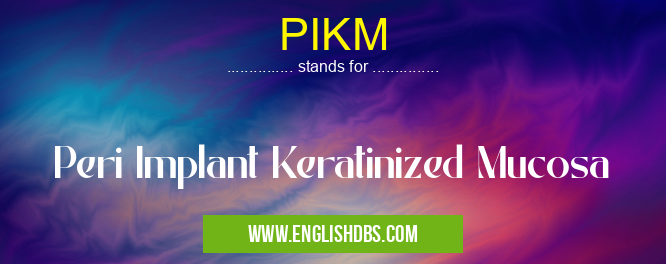What does PIKM mean in UNCLASSIFIED
Peri Implant Keratinized Mucosa (PIKM) is a crucial component of dental implantology. It refers to the band of specialized tissue that surrounds dental implants and provides structural support and protection. In this article, we will explore the significance of PIKM, its measurement, and its role in implant health.

PIKM meaning in Unclassified in Miscellaneous
PIKM mostly used in an acronym Unclassified in Category Miscellaneous that means Peri Implant Keratinized Mucosa
Shorthand: PIKM,
Full Form: Peri Implant Keratinized Mucosa
For more information of "Peri Implant Keratinized Mucosa", see the section below.
Measurement of PIKM
The width of PIKM is measured using a periodontal probe. An adequate width of PIKM is essential for maintaining implant stability and preventing peri-implant diseases. Generally, a PIKM width of 2-3 mm is considered optimal.
Role of PIKM in Implant Health
PIKM plays several vital roles in ensuring the health and longevity of dental implants. Here are its functions:
- Structural Support: PIKM provides a firm attachment between the implant and the surrounding bone, stabilizing the implant and preventing its movement.
- Protection Against Infection: The keratinized layer of PIKM acts as a barrier against bacterial invasion, protecting the implant from infections such as peri-implantitis.
- Soft Tissue Seal: PIKM creates a soft tissue seal around the implant, preventing the passage of bacteria and toxins into the underlying bone.
- Esthetics: PIKM contributes to a natural and aesthetic appearance by simulating the appearance of a healthy gingival margin.
Essential Questions and Answers on Peri Implant Keratinized Mucosa in "MISCELLANEOUS»UNFILED"
What is Peri Implant Keratinized Mucosa (PIKM)?
Peri Implant Keratinized Mucosa (PIKM) refers to the band of keratinized tissue that surrounds a dental implant. It is a crucial component of a healthy peri-implant environment, as it provides protection against bacterial invasion, inflammation, and bone loss.
Why is PIKM important for dental implants?
PIKM serves several vital functions:
- Protection against infection: It acts as a barrier against bacteria, preventing them from reaching the implant surface and causing infection.
- Maintenance of bone health: PIKM helps maintain the bone level around the implant by preventing bone resorption.
- Improved aesthetics: A sufficient band of PIKM enhances the natural appearance of the implant, making it blend seamlessly with the surrounding tissues.
How is PIKM created?
PIKM is typically established during the implant placement procedure. The surgeon creates a small incision in the gum tissue and carefully positions the implant in the jawbone. The gum tissue is then sutured around the implant, allowing it to heal and form a keratinized band.
What is the ideal width of PIKM?
The optimal width of PIKM varies depending on the location and size of the implant. However, studies have shown that a width of at least 2 millimeters is desirable for long-term implant success.
What are the risks associated with insufficient PIKM?
Insufficient PIKM can increase the risk of:
- Peri-implantitis: A destructive inflammatory condition that affects the tissues surrounding the implant.
- Implant failure: In severe cases, insufficient PIKM can lead to implant loss.
Final Words: PIKM is an essential tissue in dental implantology that plays a multifaceted role in implant stability and health. Its adequate width is crucial for preventing peri-implant diseases and maintaining a successful implant outcome. Understanding the importance of PIKM allows dental professionals to optimize treatment planning and improve the longevity of dental implants.
